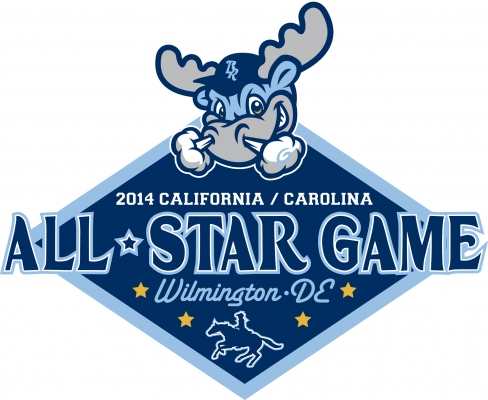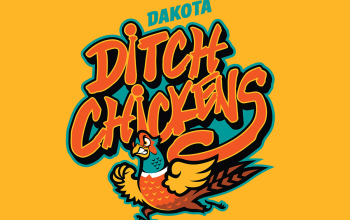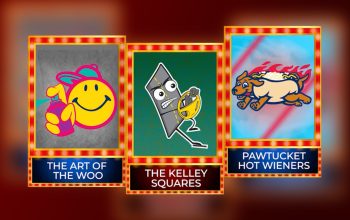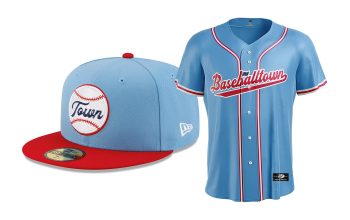
The Wilmington Blue Rocks’ name derives from large chunks of rock found in Delaware’s Christina River. How the team went from a name based on lumps of blue-ish granite to logos that feature a moose and a stalk of celery merits some explaining.
 The first iteration of the Blue Rocks was a team that played in the Interstate League from 1940 to 1952. More than four decades later, when the Peninsula Pilots, a single-A Carolina League affiliate of the Kansas City Royals, relocated to Wilmington, they decided to go with the city’s old team name and a makeshift new logo.
The first iteration of the Blue Rocks was a team that played in the Interstate League from 1940 to 1952. More than four decades later, when the Peninsula Pilots, a single-A Carolina League affiliate of the Kansas City Royals, relocated to Wilmington, they decided to go with the city’s old team name and a makeshift new logo.
“In 1993, we set up shop in January and had a game in April, so there wasn’t a lot of time to do anything,” said Chris Kemple, the team’s general manager. “We spent maybe a day trying to figure out what this logo would be.”


They went with a baseball stalwart, interlocking letters (on the left, above), knowing that they would make a change one day. The logo incorporated the state of Delaware with a diamond marking the location of Wilmington—a reference not only to baseball diamonds but also Delaware’s unofficial nickname, the Diamond State. (Thomas Jefferson considered Delaware “a ‘jewel’ among states due to its strategic location on the Eastern Seaboard,” according the state’s website.) The Blue Rocks still use a version of the interlocking B-R as one of their secondary logos (on the right, above).
It took the team a decade and a half to rebrand, and when they did, it was by incorporating their longtime mascot, a moose, into the primary logo. The new look, developed by Brandiose, was unveiled in 2010 and was immediately well received.
All of this begs the obvious question, why is the mascot of a team called the Blue Rocks a moose in the first place? Kemple credits Frank Bolton, the team’s owner/president in 1993.
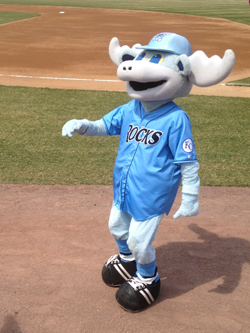 “I don’t know how he came up with Rocky Bluewinkle,” Kemple said. “I do remember him telling me it was after some bad Chinese food. I don’t know if that’s a joke or not. Obviously, it’s a play on Rocky and Bullwinkle.”
“I don’t know how he came up with Rocky Bluewinkle,” Kemple said. “I do remember him telling me it was after some bad Chinese food. I don’t know if that’s a joke or not. Obviously, it’s a play on Rocky and Bullwinkle.”
So there’s a connection (albeit tenuous) between the moose and the team name—Rock leads to Rocky, Blue sounds vaguely like Bull, there’s a famous moose in a show called Rocky & Bullwinkle, so Rocky Bluewinkle. (Not to be a stickler, but wasn’t Rocky the flying squirrel on that show? Should he be Richmond’s mascot?)
What about the team’s most popular secondary logo, Mr. Celery? Kemple starts the story with, “In minor league baseball, there are no original ideas. I stole the concept from another team.”
In 1999, Kemple was in Lake Elsinore, California, attending the all star game between the Carolina League and the California League. During the game, every time the California League scored, a pink bunny mascot came out to dance behind the wall in right field. “It was one of the funniest, one of the craziest things I had ever seen,” Kemple said. “I thought, I gotta do something like that in Wilmington.”
During the offseason, Kemple brought the idea to the team, and it was well received. But who would this character be who came out to dance—to CEL-ebrate—when the Blue Rocks scored? Kemple wasn’t sure the idea would stick, and the team didn’t want to invest a lot of money in a new mascot costume for an idea that might be scrapped after a few weeks if it didn’t work out. So they considered their options.
“We had this old beat-up celery costume that had been sitting in a warehouse for years,” Kemple said. “Actually, it was the property of our food and beverage company, Centerplate…. We dusted it off, put a guy in it, called it Mr. Celery.”
 Initially, the idea was met with skepticism, but Mr. Celery was quickly embraced, and today, his image can be seen everywhere at the stadium, and the team store features an entire wall of Mr. Celery logo items. (Sadly, the Blue Rocks were shut out 1-0 when I went to a game there earlier this season, so there was no actual Mr. Celery sighting for me.)
Initially, the idea was met with skepticism, but Mr. Celery was quickly embraced, and today, his image can be seen everywhere at the stadium, and the team store features an entire wall of Mr. Celery logo items. (Sadly, the Blue Rocks were shut out 1-0 when I went to a game there earlier this season, so there was no actual Mr. Celery sighting for me.)
With his unlikely origins, fans still look for a hidden meaning, some sort of connection. “To this day, people still ask us where it came from,” Kemple said, “whether there’s some sort of Da Vinci Code, matching numbers and letters and codes, why it’s celery. Literally it’s because we had the costume.”
Kemple is grateful for Mr. Celery’s success, even if it is something of a fluke. “It makes us in a way look like we’re geniuses,” he said, “but we didn’t know what we were doing.”
The team even tried to sell celery at concession stands, but that was pushing the envelope just a little too far. “People seemed to buy it more to throw it on the field or to use it as a prop with Mr. Celery than to actually eat it,” Kemple said.
Later this year, the Blue Rocks (and Mr. Celery) will host the Carolina League-California League All Star game for the second time (they previously hosted it in 2002). The All Star logo, predictably, features Rocky and the Blue Rocks’ color scheme, but the All Star festivities in June will feature something most baseball fans have not seen before—a backwards home run contest.
“We’re going to have the home run hitters in centerfield hitting into the grandstands, into the seats,” Kemple said.
The decision to mix up the home run contest comes after the 2002 home run contest fell a little flat because of the size of the field. The Blue Rocks’ stadium is fairly large (400 feet to centerfield) and features an outfield wall straight out of Game of Thrones—300 miles long and 700 feet tall. Hitting from the outfield in gives the team some options.
“We can move the plate up a little bit so that they’ll be able to hit more,” Kemple said. “They’re hitting into the stands, and fans will be catching the home run balls, as opposed to the home run balls flying out into a parking lot.”
The Blue Rocks play in a stadium that is more than 20 years old (though it is still very nice) and just 25 miles down the road from the Philadelphia Phillies, so to succeed, they’ve had to be creative. Their willingness to embrace and run with quirky branding ideas—whether they’re inspired by bad Chinese food or other teams’ mascots—has been key to their popularity. Now I just need them to score some runs the next time I visit so I can actually see Mr. Celery.



